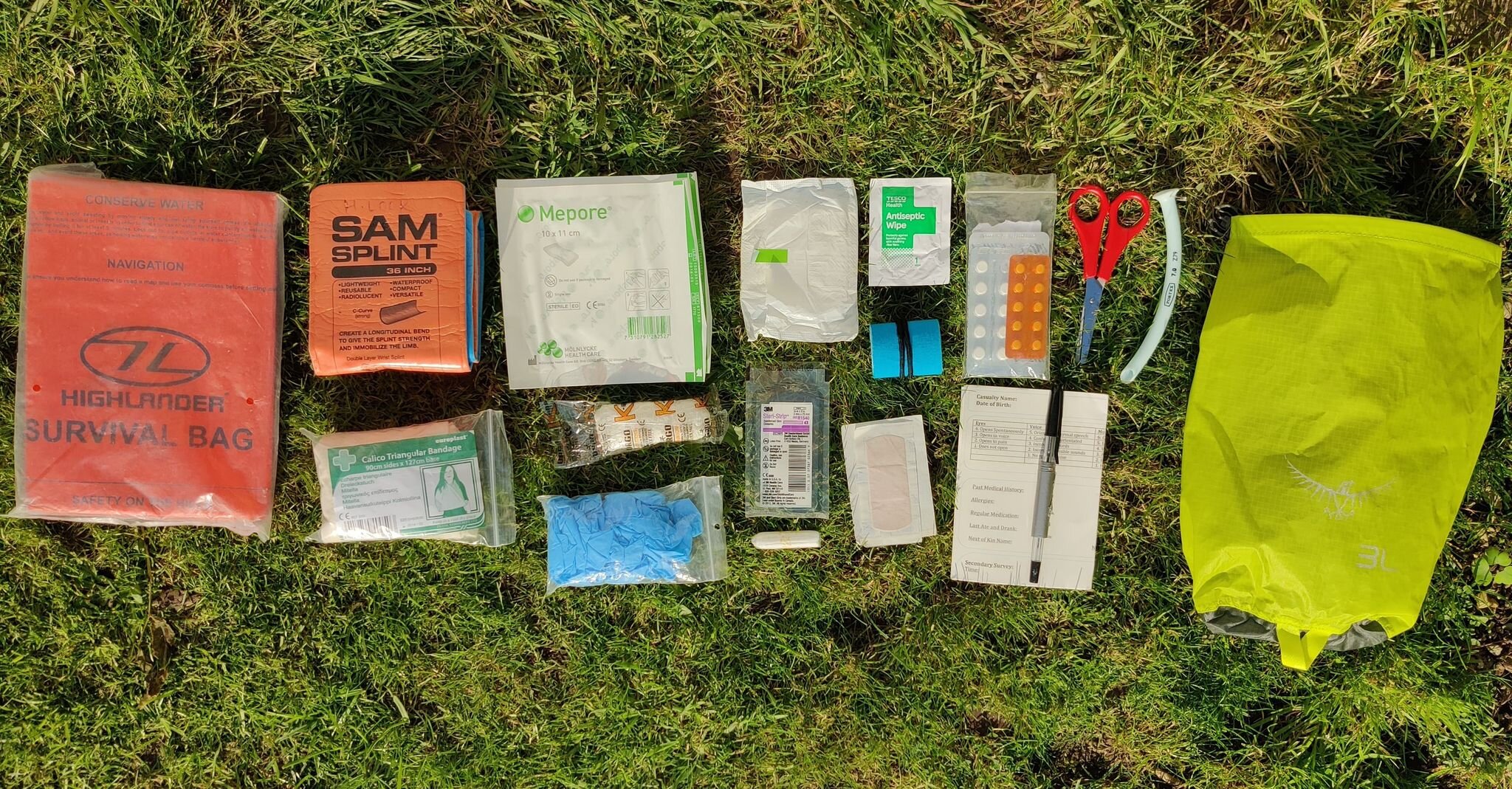Mountain Medicine: First Aid Kits and Training
By Dr Hannah Lock
It can be difficult to know where to start with first aid kits for Alpine adventures or hill days in the UK. Lots of companies sell pre-made first aid kits which are usually adequate for most people, but I personally like to tailor my kit to a specific adventure. This article explains how I go about planning the medical kit I take. I hope you find it useful.
Firstly, your mountain first aid kit is not designed to be an entire hospital and pharmacy in your bag, it is designed to be enough to patch someone up to get them to definitive medical treatment (if required), or enough to patch them up so that they can continue with their activity. You can’t carry kit for all eventualities so you have to be logical but creative with your approach. Secondly, minor injuries and illness are the most common medical issues in the mountains so don’t get too concerned about having kit to deal with serious incidents (you’ll need help for that), focus on dealing with common, minor issues where the kit you carry can make the most impact.
When I’m in the mountains with friends I usually take very little in the way of first aid kit (because I have to carry it!) so I want to ensure that the items I do carry are well thought through. I take things that are commonly required and other items that I hope I don’t have to use but that can make a significant difference in an emergency. (Important to note: if you are with a group in a professional capacity as leader/guide/medic you may have to meet certain minimum first aid kit requirements.)
Tailoring your first aid kit requires you to think about the specifics of your adventure. I would take slightly more for 3 days of Alpine mountaineering >3500 m than I would for a day walk in Snowdonia, although not too much more as I want to keep my rucksack small and light.
Here’s what I consider when deciding what to pack:
· Location
o How remote are you going, is there even an option of a rescue team helping you? If there are rescue services, how much time will they take to reach you and how much time is it to reach a hospital?
· Duration of the trek/climb
o A 1 day walk vs. a 2 week trek is a totally different kettle of fish and will require different kit.
· Group
o Are you packing your own individual kit or is the kit for multiple people? Does anyone have any specific medical problems you need to consider? Does anyone have any medical training?
· Activities
o Think about the types of injuries/illness that might occur during the activity. Low level walking has different risks to high altitude ice climbing.
· Size and weight of the kit
o Who is going to carry it, how much space do you have in your bag, do you want your bag to be as lightweight as possible?
· Items with multiple uses
o This is crucial! Try to pick items that can be used for lots of things, that way you only need a few things to help you in most situations.
· The likelihood of having to use an item vs. the item’s importance when it is used
o There is little point packing a load of random items if there is only a tiny likelihood of them being used and if you do use them they turn out not to be essential. This goes back to the size and weight of the kit; you can’t take everything! I consider – is the item life or limb saving? E.g. haemostatic gauze – it is very unlikely you would have to use it, but if you do it could save the casualty’s leg and/or life if they had a serious bleed in a remote location.
· Cost of kit
o No one has endless money and things often go out of date before they get used. You don’t have to spend much to get a really good kit.
Here are the essentials I always have in my rucksack, regardless of the adventure:
· Oral painkillers: paracetamol & ibuprofen
o Simple but effective. These simple drugs can make a huge difference in an emergency but also just for simple issues like mild joint pain towards the end of a long day or for the classic high altitude headache.
· Oral antihistamine
o Because I’m annoyingly prone to allergies and you don’t want to get caught out somewhere far from help.
· K-tape
o Kinesiology-tape, often used by sports physiotherapists has so many potential uses so it is absolutely perfect for mountain first aid kits. I use it for blister prevention and treatment, for strapping joints, as a bandage and for fixing kit (I taped a friend’s crampons with this stuff a few years ago and it lasted the several km we needed to cross the glacier back to the hut). I also carry some duct tape for similar reasons but think K-tape has a few extra common uses and is kinder on skin.
· One or two antiseptic wipes
· A few plasters & a pack of steri-strips
o Steri-strips are hugely underrated - used correctly they are brilliant and for minor wounds are far more commonly used than glue or sutures in my experience working in A&E. If you’re not sure how to apply them, this is a useful short video: https://www.youtube.com/watch?v=C5m0CYCt59E
· A few non-adherent dressings
o Can be used for small-medium wounds, or as an eye patch. I also carry a sanitary pad which as well as being used for that annoyingly unexpected period, is perfect for a spare wound dressing.
· A small penknife to cut tape etc.
I store my mountain medical kit in a brightly coloured, roll-top dry bag to keep it clean, dry and easy to find in my rucksack.
Here are some extras I would consider taking for a few days of high altitude Alpine mountaineering:
· High factor sun cream - a must have!
· Anti-diarrhoea medication – trust me, you just don’t want to get caught out with an upset stomach! So even though drugs like Imodium don’t treat the illness, they can help you manage the situation enough to get back down the mountain or at least finish the route without too much drama…hopefully.
· Rehydration sachets.
· Triangular bandage – personally I would just use K-tape to tape the broken arm to the person’s chest to immobilise it, but most people prefer the idea of using a triangular as a sling.
· A pair of latex free gloves – try to avoid contaminating yourself with someone else’s blood etc.
· A tampon - ideal for nose bleeds which occur more commonly at altitude, they can also be used to pack bigger wounds.
· Paper & pencil/pen – if an accident does happen and you need rescue, writing down some brief details of what happened, what time, where, as well as patient details (name, date of birth, past medical history, allergies, regular medication, next of kin name and number,), can be really useful for emergency services.
· Drugs relevant to altitude: diamox (acetazolomide) helps prevent and treat acute mountain sickness (by aiding acclimatisation). Even if you don’t take it as prevention, it’s worth considering carrying a few tablets to help treat someone who gets sick. Don’t forget though, the actual treatment is descent to a lower altitude – drugs should only be taken to aid descent, not as a treatment to enable ascent.
Side note: as a doctor with training and experience in mountain medicine, I take a few extra things that I haven’t listed above because they require at least some medical training e.g. a nasopharyngeal airway, a Sam splint, other drugs such as stronger pain killers, anti-sickness and drugs used in the treatment of severe altitude illness.
It is also important to mention that if you normally take any regular medication for anything to make sure you pack an adequate supply in your first aid kit and that your friends know where it is too. Also be aware that some conditions can be exacerbated by altitude so you may need to pack extra medication. Take asthma for example – if you have a history of asthma but hardly ever have to use your inhalers these days, don’t think of leaving them at home to save weight in your bag - pack a new/full reliever inhaler because the altitude and cold temperatures could trigger your asthma. It is also worth thinking about how to store certain medications you might need e.g. insulin must be kept at a certain temperature. There are plenty of solutions for this, but give yourself plenty of time ahead of your trip to start planning.
First Aid Training
So once you’ve got your kit, you need to make sure you know what to do with it. There are lots of outdoor first aid courses out there and I would highly recommend attending one if you can. I personally learn best by doing so I think the ones with lots of practical, hands on sessions are the best. Essential topics I would want to be covered by a course are:
· Calling for help
· Casualty assessment (e.g. DrABCDE)
· Bleeding and shock
· Wound management
· Casualty handling and evacuation
· Deformities/limb injuries
· Common illnesses
· Hypothermia
· Altitude illness (if possible)
There are lots of courses on offer, so before signing up to one, shop around and check to see if people are recommending that company/course before you part with you cash. I like to check out small, independent companies but when in doubt, go for well-known names in the outdoor industry.
I’ve not heard of many courses that cover altitude illness so if you can’t find one then it is vital to educate yourself some other way before your high altitude adventure begins. I have some resources on my website that you may find helpful, including my own blog articles on high altitude, as well as links to documents and websites with lots of brilliant information. See: https://drhannahlock.co.uk/
Hannah is a doctor and mountaineer based in North Wales. As well as her day job at Ysbyty Gwynedd (Bangor Hospital), she holds the diploma in Mountain Medicine and works as an expedition doctor, specialising in high altitude trekking and mountaineering.


